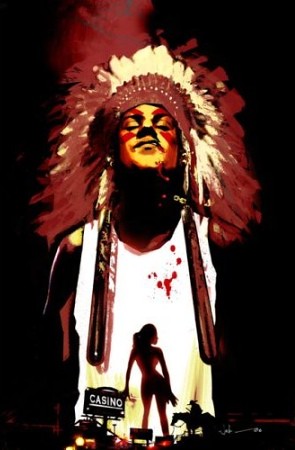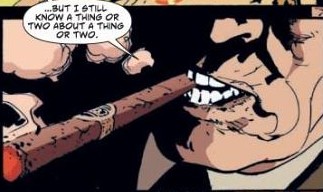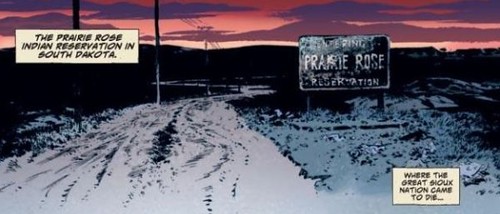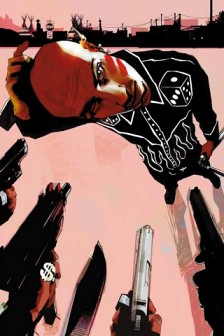Comics blogger Jog has an interesting write up/reaction to New Engineering, a wild looking collection of Manga by Yuichi Yokoyama. After describing the nearly plotless content of the book filled with continual battle scenes and bizarre landscapes, Jog gets into a nice little discussion on the expectations of US readers of manga.
It's Naruto's library of symbols, stripped of warmth and purpose, and turned into something... else.
So, in essence, it's the style of Manga, using sweat drops and nose bleeds aplenty. but it's Manga knocked on its butt until it's doing something else. Sounds pretty cool to me. But this speaks a lot to the US perception of comics and cartoons in general; Sandman and Fun Home aside, mainstream media still hasn't embraced the idea that comics aren't just brain candy for kids. Probably every couple of weeks someone I work with at the library will ask me, "So...I know you read books, too. What's the point with all these graphic novels?"
I just shake my head. What people continually seem to confuse is that they relate comics to their idea of genre, while it's really a medium that can tell all the same kinds of stories told entirely through text (and even some that you can't tell through text). Sci-fi, super-heroes, romance, humor, somber tales of regret, even experimental fiction like Karasik & Mazzucchelli's wonderful adaption of Paul Auster's City of Glass. It's not the tools used but what's done with them that matters.
I admit I'm biased, though. And I have been checking out a lot of fluffy ones lately, mostly because they provide a much needed break from all the academic papers I have to read for my classes. Just try not to look at me with too much scorn when I check out an issue of One Piece, a Chris Ware Lit-comic, and the latest Jonathan Lethem novel all at the same time. I enjoy it all.
Excelsior
Wednesday, October 24, 2007
Monday, October 22, 2007
Thoughts on the Bus
I had a very long metro ride home from class tonight. Someone apparently smelled or spotted smoke (I'm not sure which, I heard both versions) at Union Station just after I got on at the Brookland/CUA stop. Just two stops down, at New York Ave, they made everyone get off the train and told us the tracks were closed down for the next few stops. We'd have to catch a shuttle bus to Union Station and then transfer to a second one to take us to a metro station that was actually open.
So I waited about twenty minutes, packed into a bus, and went on my way. It wasn't too bad. People complained. People yelled. I didn't have to be anywhere at at certain time, so I didn't really care. Since I was standing the whole time I couldn't read. So I put on my Ipod, hit shuffle and tapped my foot throughout the whole journey.
Now I've had this idea tucked in the back of my head for a teen novel. All I really know about it is that it's set in a high school and the main character thinks he's a ninja. I haven't decided yet if he really is or not, but he at least thinks he is. But standing there in those crowded busses and metro trains, ideas and even full scenes started to and swirl around and even gel in my head. I'm sure some people thought I was crazy, standing on the bus just chuckling at my own thoughts.
There's no main conflict yet, but now I'm thinking about doing it for NaNoWriMo next month. I'm still undecided. I'd like to do it, but between the Holidays and all the projects for school we'll have to see. I'll probably start up on on November 1 and just see what happens.
Excelsior
So I waited about twenty minutes, packed into a bus, and went on my way. It wasn't too bad. People complained. People yelled. I didn't have to be anywhere at at certain time, so I didn't really care. Since I was standing the whole time I couldn't read. So I put on my Ipod, hit shuffle and tapped my foot throughout the whole journey.
Now I've had this idea tucked in the back of my head for a teen novel. All I really know about it is that it's set in a high school and the main character thinks he's a ninja. I haven't decided yet if he really is or not, but he at least thinks he is. But standing there in those crowded busses and metro trains, ideas and even full scenes started to and swirl around and even gel in my head. I'm sure some people thought I was crazy, standing on the bus just chuckling at my own thoughts.
There's no main conflict yet, but now I'm thinking about doing it for NaNoWriMo next month. I'm still undecided. I'd like to do it, but between the Holidays and all the projects for school we'll have to see. I'll probably start up on on November 1 and just see what happens.
Excelsior
Wednesday, October 17, 2007
Jury Duty
Yesterday I had my first experience with jury duty. Well, almost.
Several months ago I got a friendly questionaire from the US District Court. Mostly it asked me about my job, how close I lived to the nearest court house (about ten miles) and a few other boring questions. Maybe a month ago I got a little packet that my time to serve had finally arrived. A lot of people do whatever they can to avoid jury duty. But I was (and still am) looking forward to participating. I had dreams of Twelve Angry Men level events in my head, or at least events as dramatic as the episode of Andy Griffith where Aunt Bea has to decide if Jack Nicholson stole a t.v. set or not.
They send you all kinds of rules before you get there. They tell you what to wear (dark-colored business suits) and give you a list of things you can't bring with you: cell phones, cameras, pda's, magazines, newspapers, books, and so on. You can't even bring pen/pencil and paper to take notes. They don't want anything to distract you at all from the trial, I guess.
I got to the court a little early, which was good because I witnessed another potential juror get turned away for showing up in flip-flops and sweat pants. After signing in, I was directed into a room with rows and rows of chairs and told to wait. I would be called by my official juror number if/when they needed to speak to me.
It wasn't exactly the most diverse room. With a couple of exceptions, they were all white, and probably 2/3 were male. Nearly everyone was complaining about having to be there. The most entertaining/annoying guy was the man I dubbed The Pacer. The Pacer was probably in his mid-forties, tall and slender and his hair just starting to enter those changes from black to gray. The whole time I was there he walked back and forth, back and forth, often touching his fingers to his lips as he paced. I'm pretty sure if they allowed smoking in Federal buildings he would have been, and he probably would have sucked down a whole pack in no time. Every few minutes he would mutter something about not having his Blackberry.
From time to time some court official would come in, call out a number and take a juror away. Sometimes the juror came back, sometimes they didn't. The whole time I was there, I kept thinking about Schrödinger's cat. That poor cat put in a steel box, waiting for someone to open up the lid so it would know if it was alive or dead. Would I get to take part in a trial, or would they send me home?
I sat there about an hour and half until my number was finally called. They pulled me into a smaller room and I sat down with a man who said he was a lawyer. He asked me questions about finance law, whether or not I invest in the stock market, and what I felt about insider trading. I was sent back, and waited for another hour. When my number was called again, they told me to go home and call back on Friday to see if they wanted me to come in next week.
So I'm a cat, still waiting in that box for someone to tell me my fate. We'll see what happens on Friday.
Excelsior
Several months ago I got a friendly questionaire from the US District Court. Mostly it asked me about my job, how close I lived to the nearest court house (about ten miles) and a few other boring questions. Maybe a month ago I got a little packet that my time to serve had finally arrived. A lot of people do whatever they can to avoid jury duty. But I was (and still am) looking forward to participating. I had dreams of Twelve Angry Men level events in my head, or at least events as dramatic as the episode of Andy Griffith where Aunt Bea has to decide if Jack Nicholson stole a t.v. set or not.
They send you all kinds of rules before you get there. They tell you what to wear (dark-colored business suits) and give you a list of things you can't bring with you: cell phones, cameras, pda's, magazines, newspapers, books, and so on. You can't even bring pen/pencil and paper to take notes. They don't want anything to distract you at all from the trial, I guess.
I got to the court a little early, which was good because I witnessed another potential juror get turned away for showing up in flip-flops and sweat pants. After signing in, I was directed into a room with rows and rows of chairs and told to wait. I would be called by my official juror number if/when they needed to speak to me.
It wasn't exactly the most diverse room. With a couple of exceptions, they were all white, and probably 2/3 were male. Nearly everyone was complaining about having to be there. The most entertaining/annoying guy was the man I dubbed The Pacer. The Pacer was probably in his mid-forties, tall and slender and his hair just starting to enter those changes from black to gray. The whole time I was there he walked back and forth, back and forth, often touching his fingers to his lips as he paced. I'm pretty sure if they allowed smoking in Federal buildings he would have been, and he probably would have sucked down a whole pack in no time. Every few minutes he would mutter something about not having his Blackberry.
From time to time some court official would come in, call out a number and take a juror away. Sometimes the juror came back, sometimes they didn't. The whole time I was there, I kept thinking about Schrödinger's cat. That poor cat put in a steel box, waiting for someone to open up the lid so it would know if it was alive or dead. Would I get to take part in a trial, or would they send me home?
I sat there about an hour and half until my number was finally called. They pulled me into a smaller room and I sat down with a man who said he was a lawyer. He asked me questions about finance law, whether or not I invest in the stock market, and what I felt about insider trading. I was sent back, and waited for another hour. When my number was called again, they told me to go home and call back on Friday to see if they wanted me to come in next week.
So I'm a cat, still waiting in that box for someone to tell me my fate. We'll see what happens on Friday.
Excelsior
Friday, October 05, 2007
Review: Scalped Vol 1: Indian Country by Jason Aaron and R.M. Guera
Comics author Jason Aaron has a gift for building stories around the still-healing wounds of American history and culture. His comic The Other Side explores the horrors of the Vietnam War; with his gritty Native American crime series Scalped Aaron explores the grim conditions "on the rez".
After running away from his home on the Prairie Rose reservation at age 13, Dashiell Bad Horse returns fifteen years later, making trouble everywhere he goes. Bad Horse comes to the attention of the local crime lord, a ruthless and conniving man named Lincoln Red Crow who immediately puts Bad Horse to work as a tribal cop on his personal payroll. On the surface Bad Horse works as Red Crow’s muscle, stamping out competitors that threaten Red Crow’s hold on the tribe and silencing a contingent of protestors who oppose the developing casino that will increase Red Crow’s wealth ten-fold. But we learn early on that Bad Horse is a federal agent working undercover to bring down Red Crow and his criminal empire. Tensions increase when both a former girlfriend and Bad Horse’s mother question his return to Prairie Rose.
The basic plot owes a lot to typical mob stories, complete with an unflinching portrayal of violence, prostitution and drug abuse. The action and plotting are sharp enough to satisfy most any fan of edgy gang-style tales. Setting the story on a reservation, though, allows Aaron to explore these ideas in a fresh manner. What he has going for him is the unique palette he can draw from to build his story. It has the potential to say a lot about current perceptions of native americans and how they play into racism, culture and history.
Artist R.M. Guera's a pretty successful veteran of European comics, and his coming from that tradition really shows. The bold lines and frenetic panels to highlight the blood-and-bullets style of action. He also makes use of the western landscape, creating dramatic desert scenes that build up the tension and alienation felt throughout the story. The one real criticism I have is the way he draws faces---they are at times a bit too abstract for me. A number of characters run together visually and it's not until I read dialogue that I always knew who they were.
The real danger of this series, however, is how Aaron is playing into stereotypes. While the stereotypes are twisted into modern forms we still see a culture built around violence, drugs and extreme sexual appetites. Unfortunately, the negatives aren't balanced with any positive figures. Although a hero of sorts, Bad Horse is still pretty unlikeable; he's perpetually angry at everyone for everything and he expresses it with extreme violence.
In an interview with Silver Bullet, Aaron states that his "goal with Scalped is to make all the characters sympathetic, even the most villainous. Red Crow, in a lot of ways, will become the most sympathetic". If the story moves in a way that redeems some of these characters, a lot of the criticism will likely be turned around into praise. We see hints of this with part two of this collection. A chapter dubbed “Hoka Hey” works in layers of flashbacks, hinting at stronger development of both character and theme as the series continues. After all the flying bullets and slamming fists, that's what will keep me coming back to this series and I hope I see it.
Excelsior.
After running away from his home on the Prairie Rose reservation at age 13, Dashiell Bad Horse returns fifteen years later, making trouble everywhere he goes. Bad Horse comes to the attention of the local crime lord, a ruthless and conniving man named Lincoln Red Crow who immediately puts Bad Horse to work as a tribal cop on his personal payroll. On the surface Bad Horse works as Red Crow’s muscle, stamping out competitors that threaten Red Crow’s hold on the tribe and silencing a contingent of protestors who oppose the developing casino that will increase Red Crow’s wealth ten-fold. But we learn early on that Bad Horse is a federal agent working undercover to bring down Red Crow and his criminal empire. Tensions increase when both a former girlfriend and Bad Horse’s mother question his return to Prairie Rose.
The basic plot owes a lot to typical mob stories, complete with an unflinching portrayal of violence, prostitution and drug abuse. The action and plotting are sharp enough to satisfy most any fan of edgy gang-style tales. Setting the story on a reservation, though, allows Aaron to explore these ideas in a fresh manner. What he has going for him is the unique palette he can draw from to build his story. It has the potential to say a lot about current perceptions of native americans and how they play into racism, culture and history.
Artist R.M. Guera's a pretty successful veteran of European comics, and his coming from that tradition really shows. The bold lines and frenetic panels to highlight the blood-and-bullets style of action. He also makes use of the western landscape, creating dramatic desert scenes that build up the tension and alienation felt throughout the story. The one real criticism I have is the way he draws faces---they are at times a bit too abstract for me. A number of characters run together visually and it's not until I read dialogue that I always knew who they were.
The real danger of this series, however, is how Aaron is playing into stereotypes. While the stereotypes are twisted into modern forms we still see a culture built around violence, drugs and extreme sexual appetites. Unfortunately, the negatives aren't balanced with any positive figures. Although a hero of sorts, Bad Horse is still pretty unlikeable; he's perpetually angry at everyone for everything and he expresses it with extreme violence.
In an interview with Silver Bullet, Aaron states that his "goal with Scalped is to make all the characters sympathetic, even the most villainous. Red Crow, in a lot of ways, will become the most sympathetic". If the story moves in a way that redeems some of these characters, a lot of the criticism will likely be turned around into praise. We see hints of this with part two of this collection. A chapter dubbed “Hoka Hey” works in layers of flashbacks, hinting at stronger development of both character and theme as the series continues. After all the flying bullets and slamming fists, that's what will keep me coming back to this series and I hope I see it.
Excelsior.
Subscribe to:
Comments (Atom)



